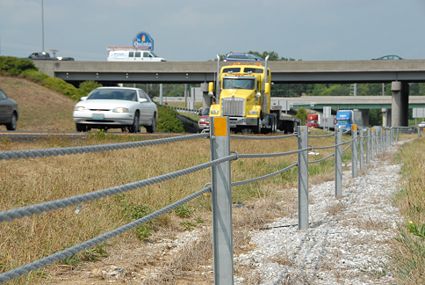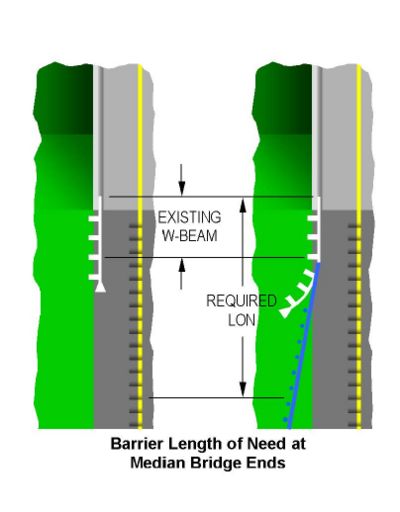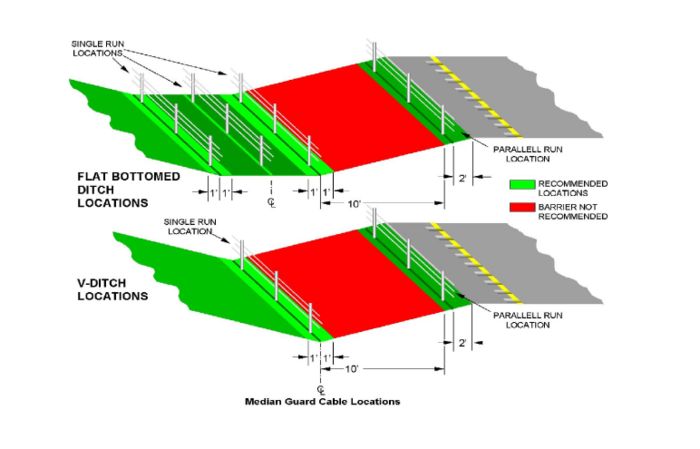606.2 Guard Cable
| Key Points |
Guard cable consists of steel cable mounted on weak posts. It is relatively inexpensive to install and very effective at capturing errant vehicles.
Contents
606.2.1 Types of Guard Cable
There are two types of guard cable systems in use: low-tension and high-tension. Each system has advantages and disadvantages. Generally, a high-tension system has a higher initial cost with lower long-term maintenance costs and concerns. MoDOT is allowing high-tension cable as a no-cost change order whenever a subcontractor is able to provide it at the same cost as low-tension.
| For Additional Information |
| Maintenance |
| Installing Guard Cable and Safety Information about Guard Cable |
| Video |
| Successful guard cable test |
606.2.1.1 Low-Tension. Since no single producer exclusively manufactures low-tension guard cable, this system has been commonly called the “U.S. generic” system. Low-tension guard cables are tensioned only enough to eliminate sag between posts. Large springs at either end of the cable run are compressed, according to temperature, to achieve the system’s low tension.
When a vehicle impacts the low-tension system under normal conditions, the cable laterally moves as much as 12 ft. This movement is known as the dynamic deflection.
Given the lack of tension in the system, individual installations, or “runs”, of cable are limited to 2000 ft. with an anchor assembly at each end. When a vehicle strikes low-tension cable, the system will not function properly if struck by another vehicle since the cables will be loosened. It is critical to repair the guard cable promptly.
| LOW-TENSION | |
|---|---|
| Advantages | Disadvantages |
| • low initial cost | • individual "runs" are limited to 2,000 ft. |
| • employs readily available materials | • entire run is ineffective after a single strike |
| • large deflections | |
| HIGH-TENSION | |
| Advantages | Disadvantages |
| • lower maintenance costs | • can have higher initial cost |
| • unlimited length of runs | • all systems are proprietary |
| • cable stays strung after impact allowing the rest of the system to function | • unfamiliarity in most states |
| • lower deflections | |
606.2.1.2 High-Tension. High-tension cable looks very similar to low-tension cable but the two systems are very different in most other aspects. High-tension guard cable consists of three or four pre-stressed cables supported by weak posts. Currently, all high-tension systems are proprietary, that is, marketed under exclusive rights of a specific manufacture. Five systems are currently marketed in the United States.
During installation, the cables are placed on the posts and then tightened to a specific tension, ranging from approximately 2,000 to 9,000 pounds according to temperature. Due to this tightening, the cable installations can be of indefinite length. In fact, the runs are typically only limited by the presence of obstacles such as median openings or bridge columns.
Under normal conditions, when a vehicle impacts the high-tension system the cable laterally deflects as much as 8 ft. The inherent tension within the system also allows the cable to remain strung, even after an impact removes several posts. This allows the remainder of the run to continue functioning normally.
606.2.2 Testing Criteria
Within the National Cooperative Highway Research Program Report No. 350 (NCHRP 350) are six separate test levels (TL) representing different vehicles, impact angles and speeds.
Test level three (TL-3) is probably the most common as it establishes safety criteria for both small cars and pickups at 60 mph. This category of traffic accounts for nearly 90% of all vehicle traffic in Missouri.
The table below summarizes data for the six test levels:
Table 1 What is TL-3?
| Test Level | Vehicle | Angle (degrees) | Speed |
|---|---|---|---|
| 1 | 1800 lb. car | 20 | 30 mph |
| 4400 lb. pickup | 25 | 30 mph | |
| 2 | 1800 lb. car | 20 | 45 mph |
| 4400 lb. pickup | 25 | 45 mph | |
| 3 | 1800 lb. car | 20 | 60 mph |
| 4400 lb. pickup | 25 | 60 mph | |
| 4 | 1800 lb. car | 20 | 60 mph |
| 4400 lb. pickup | 25 | 60 mph | |
| 17,600 lb. Single-Unit Truck | 15 | 50 mph | |
| 5 | 1800 lb. car | 20 | 60 mph |
| 4400 lb. pickup | 25 | 60 mph | |
| 80,000 Semi Truck (Cargo) | 15 | 50 mph | |
| 6 | 1800 lb. car | 20 | 60 mph |
| 4400 lb. pickup | 25 | 60 mph | |
| 80,000 lb. Semi Truck (Tanker) | 15 | 50 mph |
A roadside safety hardware feature must undergo rigorous safety tasting before it can be used on the National Highway System (NHS). Most states have adopted the same testing criteria for highways that are not on the NHS. The standard by which all roadside safety features are measured is contained within the NCHRP 350.
NCHRP 350 evaluates safety hardware according to three general factors:
- Structural Adequacy: the system must contain and redirect the vehicle with no under-riding, overriding or penetration.
- Occupant Risk: fragments of the system cannot penetrate the passenger compartment, the vehicle must remain upright during and after the collision, and the passenger must not undergo excessive impact or deceleration.
- Vehicle Trajectory: after the impact, the vehicle should not intrude into adjacent traffic lanes nor should it exit the system at an angle greater than 60% of the entry angle.
606.2.3 Design Guidelines
A guard cable barrier is to be considered for median applications on freeways where cross-median accidents are occurring. Guard cable used at any location other than in the freeway median will require approval through the design exception.
For medians wider than 36 ft. (11 m) as measured between the edges of travelway, the installation of guard cable as a median barrier on freeways is to be considered when one or more of the following conditions exist:
- On a horizontal curve with radius less than 2000 ft. (609.6 m)
- On “stepped” medians (opposing directions of traffic are at different levations and median slopes are steeper than 1V:6H)
- Accident history (in particular, areas with a cross- median accident rate exceeding 0.8 per 100 million vehicle miles)
- In the vicinity of traffic conflict points including interchange ramps
- Rapidly increasing volumes of traffic
- In areas where the level of service of the freeway is “D” or less
The designer is to evaluate the need to provide guard cable in these situations and document the results of the evaluation.
Sheet 3 of Warrant for Median Barriers presents three basic median sections for which placement of guard cable is identified: a depressed “Standard” median with a ditch section, a stepped median with significant differences in elevation and a raised median with a median berm. In all situations, the slopes and the ditch section are to first be checked to determine if the guidelines previously stated suggest installation of a cable barrier.
- If both slopes are equal to or flatter than 1V:6H (Illustration 1, Sheet 3 of 5), a barrier is to be placed at the center of the median.
- If an embankment slope is steeper than 1V:6H (Illustration 2, Sheet 3 of 5), a barrier is to be placed on the 1V:6H or flatter slope at least 14 ft. from the shoulder point of the opposing lanes of travel.
- Placement criteria for barriers in raised medians, or median berms (Illustration 3, Sheet 3 of 5) have not been clearly defined. Research has shown that a cross-section of sufficient height can redirect vehicles impacting it at relatively shallow angles. Generally, if the cross-section itself is not adequate to redirect errant vehicles (i.e. the slopes are relatively flat), a guard cable barrier is to be placed at the apex of the cross-section.
In situations where median slopes are steeper than 1V:6H the median is to be reshaped, if at all possible, to attain cross-slopes that are 1V:6H or flatter. If utilities are present in the center of the median, the guard cable alignment may be offset as much as 3 ft.
To be effective, a cable barrier must be mounted on a moderate slope (1V:6H or flatter). The approach to the cable barrier from the travelway must not have a curb or a ditch.
Following installation of guard cable or access control cable, controlling vegetation beneath and immediately adjacent to the cable may not be practical by mowing or hand trimming methods. Typically, herbicide will be applied under the cable to control vegetation and minimize hand trimming. Placement of aggregate bedding material as a rock ditch liner 4 in. deep and 4 ft. wide and a vegetative barrier (weed block) beneath guard cable or access restraint cable during installation is recommended to minimize washout of the median due to lack of vegetation. See Standard Plan 606.41 for details of aggregate bedding material used as ditch liner beneath cable.
Although cable system installation is relatively inexpensive compared to a concrete barrier or Type B guardrail system and performs well when hit, it must be repaired after each hit to maintain its effectiveness. This repair must be done as quickly as possible after a hit to ensure the effectiveness of the barrier. Consequently, its use in areas where frequently hits are likely is not recommended and other types of median barrier are to be considered.
606.2.4 Installation
Standard Plan 606.41 provides the installation criteria for three-strand, low-tension guard cable. High-tension guard cable is to be installed according to each system’s specifications, information that is usually available online.
606.2.4.1 Length of Need. Like guardrail, all guard cable systems approved for use in Missouri have passed NCHRP 350 TL-3 testing. Therefore, they represent a legitimate roadside safety device and may substitute for the W-beam guardrail length of need (LON) absent from many median bridge ends. This practice is only financially expedient if median guard cable is present or if guard cable is being designed for the median.
In locations where no cable is present and safety concerns warrant a LON correction to the W-beam rail, the correction should be made with the guardrail. Standard Plan 606.41 provides the details for transitioning guard cable to W-beam guardrail.
606.2.4.2 Slopes. Guard cable, like most roadside safety hardware, is intended for use on slopes that are 1V:6H or flatter. In practice, however, slopes as flat as 1V:6H are often the exception. MoDOT and other DOTs have observed virtually no difference between the success rates of guard cable installed on slopes as steep as 1V:5H and those on 1V:6H. The Roadside Design Guide states, “…a barrier may be considered operational if it has been used for an extended period and has demonstrated satisfactory field performance in terms of construction, maintenance, and crash experience.” Therefore, on new construction projects having guard cable installed, the inslopes are to be no steeper than 1V:6H. For rehabilitations, slopes as steep as 1V:5H are permitted.
606.2.4.3 Parallel Installations. The preferred method to achieve 1V:5H or flatter slopes is to re-grade the median. However, in certain situations such as areas of critical drainage gradient or differential profile grades, additional earthwork within the median is not an option. In these cases, parallel installations of guard cable are to be specified.
The ideal location for each parallel run is 2 ft. from the edge of the shoulder. This location maximizes the distance from the through traffic while still taking into account the bumper height of the errant vehicle. Generally, the guard cable is to be located as far from the travelway as possible to avoid non-critical or nuisance impacts.
The bumper height of the impacting vehicle is critical to the function of the system. If the vehicle is slightly airborne after leaving the roadway, it may vault over the entire system. If the vehicle’s suspension is completely compressed at impact, the vehicle may go under the lowest cable and pass through the system.
606.2.4.4 Cross-Sectional Details. Because the widespread use of median guard cable is a relatively recent occurrence, specific placement geometrics are being developed and tested, so there is very little written guidance. Certain conclusions can be drawn, however, from the AASHTO and FHWA research, other states’ experience and MoDOT’s own in-service performance.
Due to the importance of the bumper height, it is clear that the barrier performs better in certain locations than in others. Generally, the barrier should not be placed from 1 to 10 ft. from the vertex of a V-ditch.
MoDOT’s practice of placing cable at the centerline of a flat-bottomed ditch should neither be discontinued nor retrofitted. Ongoing research may yield results that recommend placement at either vertex of the ditch.
Cable placed at these points should be oriented with the two-cable side facing the nearest traffic.
| Brifen: Brifen USA |
| CASS: Trinity Industries, Inc. |
| Gibraltar: Gibraltar |
| Safence: Safence, Inc. |
| U.S. High Tension: Marion Steel Company |
606.2.5 Maintenance Planning Guidelines for Guardcable
These Maintenance planning guidelines apply to both major and minor roads.
| Code: R227 |
Definition The time and expenses incurred for installing and maintaining fences along the roadway, guardrails and end treatments, guardcable and impact attenuator devices for roadside obstacles as well as all costs to maintain concrete traffic barriers, sidewalks and bicycle paths and raised pavement markers.
Purpose To restore guardcable.
Scheduling As needed
Recommended Equipment
- Truck
- Post drive
- Traffic Control Equipment, refer to Traffic Control for Field Operations.
Recommended Material
- cable
- post
- anchors
Recommended Procedure
1. Place traffic control devices as needed.
2. Remove damaged cable and posts.
3. Install new posts and cable.
4. Remove traffic control devices.
Safety Wear all appropriate Personal Protection Equip (PPE). Refer to Safety Policies, Rules & Regulations-Employee Handbook .
Other Considerations None.
Reference Sec 606



